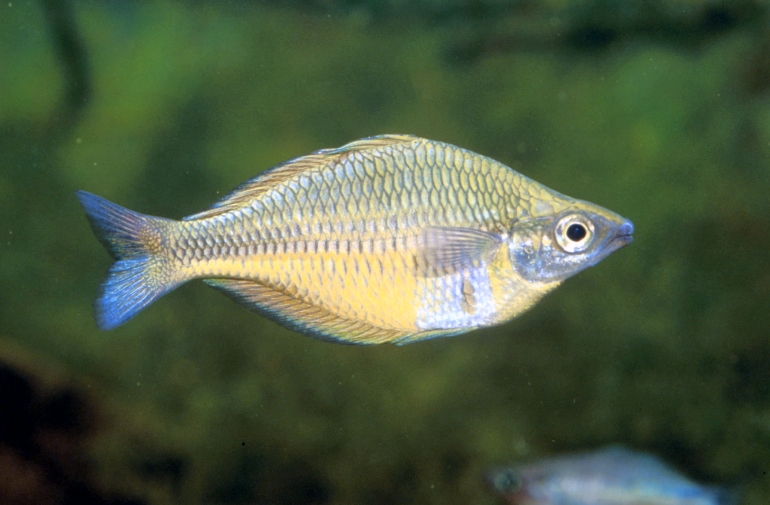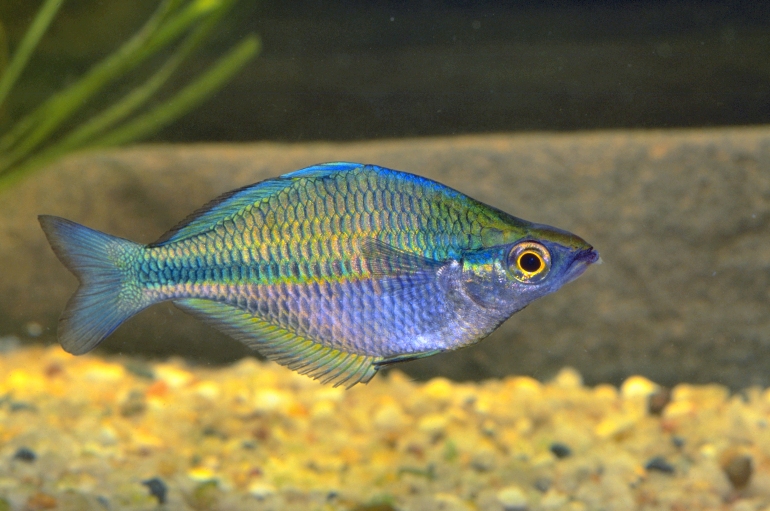|
NA.jpg) |
M. lacustris (wild-caught male) - photo© Neil Armstrong |
Munro, 1964
Lake Kutubu Rainbowfish
Species Summary
An Australian patrol officer, C.E.T. Terrell, first collected this species in Lake Kutubu during 1955. He sent preserved specimens to Australian ichthyologist, Ian Munro, who in 1964 described them as Melanotaenia lacustris. Ian Munro (1919-1994) worked with the CSIRO Division of Fisheries Research and was an early pioneer in the identification of Australian and New Guinea Rainbowfishes. He later went on to publish "The Fishes of New Guinea" in 1967.
Melanotaenia lacustris is closely related to Melanotaenia mubiensis. Large adults of the two species have very similar colouration. However, they differ in several features, including body depth, eye size, and modal fin ray counts. Adults of Melanotaenia mubiensis are much more slender than those of Melanotaenia lacustris; M. mubiensis had an average depth as percent of the SL of 38.4 compared to an average of 47.2 for M. lacustris. The eye diameter of M. lacustris is larger than the snout length, but in M. mubiensis it is shorter or equal to the snout length. Although the two species have overlapping counts for dorsal, anal, and pectoral fin rays, there are significant modal differences. M. mubiensis most frequently has 14 or 15 dorsal rays, 21 or 22 anal rays, and 14 pectoral rays compared to usual counts of 12 or 13, 18 or 19, and 15 respectively for M. lacustris.
Depending on water conditions, captive environment and diet, M. lacustris can display an array of different colours and patterns ranging from cobalt blue, steel blue, aquamarine through to lighter and darker shades of turquoise. When spawning the nape area changes to a bright orange or gold colouration. Males are more brightly coloured, larger, and with a body depth of 4-5 cm, much deeper bodied than females. They may reach a maximum size of 12 cm, but are usually less than 10 cm.
NA.jpg) |
M. lacustris (wild-caught female) - photo© Neil Armstrong |
Distribution & Habitat
Melanotaenia lacustris have been collected in Lake Kutubu and the Soro River, which is the main outlet stream of the lake. The Soro River is located in the northwest and is known as the Soro River for only a few kilometres but is essentially the beginning of the Digimu River, which is a tributary of the Mubi River.
Lake Kutubu is a high-altitude lake located in the centre of the Southern Highlands Province at an elevation of 800 metres above sea level, about 35 km southwest of the provincial capital, Mendi. It is the largest perched lake in PNG and the country's second largest lake after Lake Murray in the Western Province. The lake has a total area catchment of about 70 km² of which open water comprises approximately 50 km² and reed-beds and swamp forest another 20 km². It is about 19 km long and 4 km wide at its widest point, with a maximum depth of about 70 metres and a mean depth of 36 metres.
The accurate delineation of the lake's catchment is complicated owing to the extensive karst terrain. The lake is fed through a series of small creeks and subterranean rivers that flow beneath the surrounding limestone and karst ranges. Swamp forests occur at the south-eastern and north-western ends of Lake Kutubu. The main surface input comes from the Tugibu River and Kaimari Creek in the northwest catchment. They flow through the swamp forests before entering Lake Kutubu. Sama'a, Sumi and Gesege creeks are of secondary importance. Numerous minor streams also drain into the lake, but most of these have very small catchments and flow only following local rain events. Inflowing streams have water temperatures approximately 8°C lower than the surface lake water. It is likely that much of the flow in these streams is derived from subterranean streams from the extensive karst terrain that dominates the upland catchments.
 |
M. lacustris - photo© Gunther Schmida |
The climate in the Lake Kutubu catchment is warm and wet, with little variation throughout the year. The mean annual temperature is 23°C. Mean monthly temperatures range between 21.5 and 24°C, with July and August being the coolest period of the year. Mean daily temperature ranges from 17.3°C (minimum) to 28.6°C (maximum). The minimum temperature recorded was 5°C, and the maximum was 39°C. Annual average rainfall is 4500 mm (generally evenly distributed over the year with August-October being wettest). Water quality of the lake is characteristically high. Lake Kutubu water is alkaline with pH of 7.6 to 8.1, and its conductivity ranges from 166 to 203 µS/cm, which reflects the dominance of dissolved minerals, such as calcium and bicarbonates, derived from the dissolution of limestone of the catchment's karst terrain.
Unfortunately, Lake Kutubu is situated in a very vulnerable location where oil and gas operations are currently underway and set to expand in the future. The development of the liquefied natural gas reserves could potentially increase the deleterious impacts on the ecology and the biodiversity of the Lake Kutubu catchment through the opening up new areas of forest, and a further influx of settlers from other areas of PNG. There is an abundance of natural resources in New Guinea, but their use has become rapid and unsustainable. Forest degradation as a result of industrial logging is prevalent throughout the country. River basins and their ecosystems are being threatened due to human induced actions.
A fish kill in the lake, which began in January 2013 and lasted for 6 months, was characterised by fish pathologies consistent with epizootic ulcerative syndrome. The event coincided with an inflow of a plume of white particulates from the north east, where hydrocarbon companies carried out extensive horizontal drilling in 2012 - 2013. The fish kill substantially reduced the fish catch from the mix of species found in previous surveys of 1995 and 1997. In addition, heavy rains in 2010 - 2012 released farmed fish into the lake, and in May 2015, fishers report that the fish catch is now dominated by tilapia (Smith et al. 2016).
 |
M. lacustris - photo© Neil Armstrong |
Remarks
In late 1983, Gerald Allen, John Paska, and Barry Crockford collected approximately 40 live specimens. Only 4 fish (1 male and 3 females) survived the journey back to Australia and a week after arriving in Melbourne the only male became infected with hook worm and subsequently died. The aquarium hobby had to wait another 3 years before Heiko Bleher was able to collect further live specimens. He returned in 1988 together with Gerald Allen and once more was able to bring back live specimens for the aquarium hobby.
Literature
Allen G.R. (1991) Field guide to the freshwater fishes of New Guinea. Christensen Research Institute, Madang, Papua New Guinea.
D'Cruz R. (2008) Lake Kutubu Catchment Management Plan, Aonyx Environmental, Malaysia.
Esso Highlands Limited (2005) PNG Gas Project Environmental Impact Statement.
Jenkins A. & P. Buston (1997) Distribution and abundance of the fishes of Lake Kutubu. Consultancy report to the WWF Kikori ICDP.
Munro I.S.R. (1964) Additions to the fish fauna of New Guinea. Papua New Guinea Agricultural Journal 16 (4): 141-186.
Osborne P.L. & R.G. Totome (1992) Influences of oligomixis on the water and sediment chemistry of Lake Kutubu, Papua New Guinea. Archive Für Hydrobiologie, 124: 427-449.
Smith P.T., B.Y. Imbun and F.P. Duarte (2016) Impacts of a Fish Kill at Lake Kutubu, Papua New Guinea. Pacific Science, 70(1): 21-33.
Adrian R. Tappin
Updated September, 2016



|

